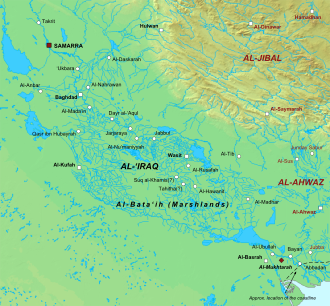| Iraq theater (Zanj Rebellion) | |||||||
|---|---|---|---|---|---|---|---|
| Part of the Zanj Rebellion | |||||||
 Map of lower and central Iraq (black) and the surrounding regions (red) during the Zanj Rebellion. | |||||||
| |||||||
| Belligerents | |||||||
| Abbasid Caliphate | Zanj rebels | ||||||
| Commanders and leaders | |||||||
|
Ju'lan al-Turki Sa'id ibn Salih al-Hajib Mansur ibn Ja'far al-Khayyat Abu Ahmad al-Muwaffaq Musa ibn Bugha Ahmad ibn Laythawayh Abu al-'Abbas ibn al-Muwaffaq |
†Ali ibn Muhammad (POW)Yahya ibn Muhammad al-Bahrani (POW)Sulayman ibn Jami' †Ahmad ibn Mahdi al-Jubba'i, (POW)Sulayman ibn Musa al-Sha'rani | ||||||
The Iraq theater was one of two major areas of operations during the Zanj Rebellion, the other being the neighboring province of al-Ahwaz.
The revolt, which began in September 869 in southern Iraq, was initially limited to the region around the port city of Basra, as well as the southern districts of al-Ahwaz to the east. Efforts by the Abbasid caliphs in Samarra to crush the rebellion proved ineffectual, and several towns and villages were occupied or sacked. Basra itself fell in September 871 following an extended blockade, after which the city was burned and its inhabitants massacred. A retaliatory campaign undertaken by the caliphal regent Abu Ahmad ibn al-Mutawakkil (known by his honorific of al-Muwaffaq) against the rebels in 872 ended in failure, and the Zanj remained on the offensive over the next several years.
The continuing inability of the Abbasid central government to suppress the revolt, caused in part by its preoccupation with fighting against the Saffarid Ya'qub ibn al-Layth's advance into Iraq, eventually encouraged the Zanj to expand their activities to the north. A campaign by the rebels to occupy the marshlands between Basra and Wasit in 876 proved successful, and soon they made their way into the district of Kaskar. By 879, the rebellion reached its furthest extent; Wasit was sacked and the rebels advanced northwest along the Tigris, coming to within fifty miles of Baghdad.
The Abbasid government finally regained the initiative in the war in late 879, when al-Muwaffaq sent his son Abu al-'Abbas (the future caliph al-Mu'tadid) with a major force against the rebels. Al-Muwaffaq himself joined the offensive in the following year, and over the next several months the government forces succeeded in driving the rebels back toward their "capital" of al-Mukhtarah, to the south of Basra. Al-Mukhtarah itself was put under siege in February 881, and its fall in August 883, combined with the death or capture of most of the rebel commanders, brought the revolt to an end.
In the opening stages of the war, the Zanj were personally led by the revolt's leader 'Ali ibn Muhammad. Following the construction of al-Mukhtarah, however, 'Ali seldom went into the field himself, and the rebels armies in Iraq came to be led by several of his deputies, such as Yahya ibn Muhammad al-Bahrani and then, after the latter's capture and execution in 872, Sulayman ibn Jami', Ahmad ibn Mahdi al-Jubba'i, and Sulayman ibn Musa al-Sha'rani. The Abbasid government, for its part, rotated a number of officers to prosecute the war against the Zanj, but few of these made significant progress in quelling the rebellion prior to 879.
The Zanj armies, bolstered by allied Arab tribesmen, included a mix of both infantry and cavalry troops, and were able to repeatedly score victories against the government forces in both pitched battles and ambushes. Both sides were also heavily reliant on watercraft to navigate the extensive canal system of lower Iraq and the waterways of the marshlands, and barges were frequently used to transport both men and supplies. The rebels also undertook other activities in the districts under their control, such as constructing fortresses, securing agreements with neighboring villages, collecting taxes and supplies, digging canals, and minting their own coins.[1]
- ^ Popovic 1999, pp. 129 ff., provides an overview of the internal activities of the Zanj "state".